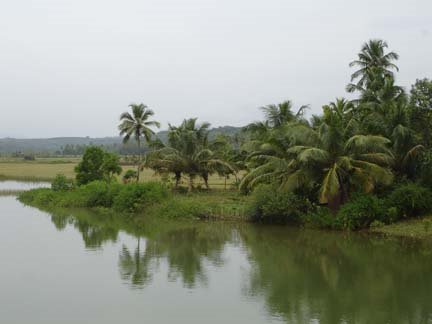
Recent archaeological excavations at Jwalapuram, in Kurnool district of Andhra Pradesh, by Dr. Michael Petraglia (University of Cambridge, U.K) in association with Prof.Kori Settar (Karnataka University) and Dr.Venkatasubbaiah (Kurnool, Andhra Pradesh) showed evidences for settlement of anatomically modern humans in southern India before 74,000 years ago. The eruption of the Toba volcano in Sumatra some 74,000 years ago was a major volcanic event in the human history. The ash thrown up high into the atmosphere by the volcanic explosion reached India and deposited as layers of volcanic tephra found at Jwalapuram excavations. Apparently, the early inhabitants of south India survived the volcanic eruption without pronounced devastation as assumed by earlier studies. (see also, Post. 38).
Excavations at Jwalapuram have unearthed fine stone flakes used tools for various purposes by the primitive human settlers. The stone tool assemblages used by early men at Jwalapuram were similar to those produced in Africa at the same time. Similar stone implements have been unearthed in Malaprabha river valley, Hunsigi and Baichbal valleys.
Neolithic Bronze Age South India
Archeological studies by Dorian Fuller (England) in association with Ravi Korisettar and. Venkatasubbaiah and revealed existence of numerous sites of the Neolithic cultures (2800 BC-1200 BC) spread in the Krishna and Tungabhadra river valleys of Karnataka and Andhra Pradesh. These ancient villages and settlements on the southern peninsula are roughly contemporaneous with the Bronze Age settlements of the Indus valley in Northwest India and Pakistan. Two important categories of Neolithic sites have been recognized: habitation villages and cattle-herd settlements.
Agriculture was the mainstay in the permanent habitation sites. Villages were located margins of granite hills, possibly in the vicinity of springs or river. The studies showed evidences for the cultivation of small millet-grasses (like brown-top millet, Brachiaria ramosa, and bristley foxtail grass, Setaria verticillata) and pulses [like urd (black gram,Vigna mungo), green gram (mung bean, Vigna radiate), and horsegram, Macrotyloma uniflorum]. These crop species are native to Southern India and were probably domesticated in the region. In addition there is evidence for the use of tuber foods. During the later Neolithic (from ca. 1800 BC) a number of other crops including Wheat (Triticum sp..) and Barley (Hordeum vulgare) were introduced from the northwest (Indus-Pirak region) and Hyacinth Bean (Lablab purpureus) and Pearl Millet (Pennisetum glaucum) of African Origin. Rice (Orizha sp.)is supposed to have been introduced at a later stage.
The 'ash mound' sites consist of large, heaped accumulations of burnt cattle dung, the largest about 8 meters in height and 40 meters in diameter. Archaeological evidence from a couple of the ash mounds indicates sites of ancient cattle penning where dung was allowed to accumulate and periodically burnt, perhaps in seasonal rituals. The ash mound sites were camps of groups linked to the agricultural production sites.



